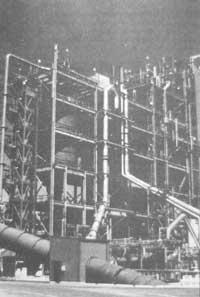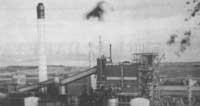Again coal becomes gas
1989/09/01 Aizpurua Sarasola, Joxerra Iturria: Elhuyar aldizkaria

The availability of gaseous fuel has important advantages. Compared to electricity, while gaseous fuel can be stored in tank, electricity cannot be stored. Along with liquid fuels, the gas does not deposit waste in containers used for transport or storage. Together with solid fuels, gas can be distributed freely and successively in specific proportions from a control center. Operators can instantly measure the gas flow and modify its composition.
All these advantages also offer natural gas. In the UK, for example, with the extraction of natural gas from the North Sea came the end of urban gas. Coal gas extraction was an expensive and low-performance process, with only 25% of coal energy being used. Natural gas needed a very economical process and left no solid waste. The energy it could supply was 38 cubic megawatts, which is about double the urban gas. There was also a lot. For this reason, in the years 1960-1970, it stopped extracting gas from coal and has since taken over natural gas in industrialized countries.
However, few engineers, especially in the UK and the US, have worked on finding better methods for gasification of coal. The process of gasification of coal had to be reduced and, on the other hand, it was necessary to control the waste that could be poured from the combustion of the gas, since the anti-pollution regulation was increasingly demanding.
Research began to bear fruit in the past decade. The second generation of carbon dioxide is born. The experimental facilities that have contributed to the emergence of this new generation were: California’s “Coll Water” unit, Texas’ “Deer Park” unit, Lousiana’s “Baton Rouge” unit and Scotland’s “Westfield” unit.
In the “Coll Water” unit, the gasifier transforms coal into gaseous fuel. This fuel is burned in a gas turbine supplying electricity. The heat extracted from the gas gasifier and gas turbine produces steam that feeds a steam turbine. The steam turbine also supplies electricity, with a net total power of 94 megawatts. You can also use different coals. And, for example, waste dumped into the air from burning coal of 3% sulfur (common coal) is 80% below the limit set by the U.S. Environmental Protection Organization.
Although this result is satisfactory, the unit is in danger of closing, as the price of energy from natural gas regattas is even cheaper.

The results of the tests that the “Deer Park” unit had to withstand have been positive. Specifically, it can gasify any type of coal and the level of pollution obtained from its streams is lower than required by the regulations.
The Scottish “Westfield” unit investigates combined cycles. That is, coal is accompanied by other fuels such as natural gas or diesel. In order to work this way, the installation must be modulable. The modules to be incorporated will be governed by the commercial price of each fuel.
Looking ahead, to meet human energy needs, coal will occupy a space, but not independently. It seems that mixed or flexible installations will be the ones with the greatest possibilities. As could not be otherwise, these facilities will be subjected to harsh anti-pollution standards, increasingly harsh without a doubt. Therefore, the processing and combustion of coal and other fuels should be done with more attention.

Gai honi buruzko eduki gehiago
Elhuyarrek garatutako teknologia



